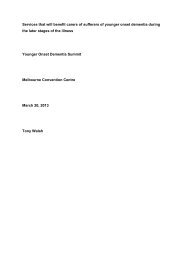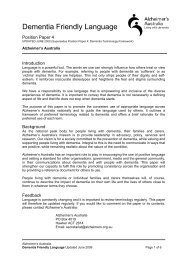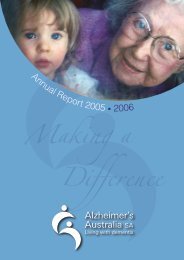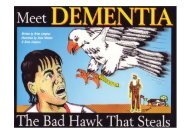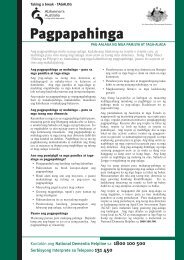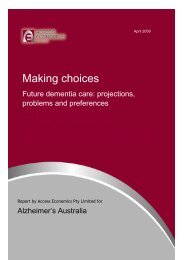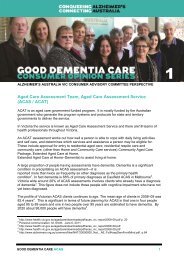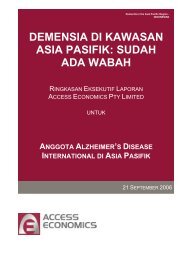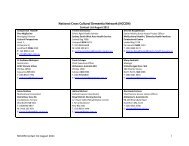dementia estimates and projections: australian states and territories
dementia estimates and projections: australian states and territories
dementia estimates and projections: australian states and territories
Create successful ePaper yourself
Turn your PDF publications into a flip-book with our unique Google optimized e-Paper software.
Dementia <strong>estimates</strong> <strong>and</strong> <strong>projections</strong>:Australian States <strong>and</strong> Territories1. BACKGROUNDAccess Economics (2003) provided <strong>estimates</strong> <strong>and</strong> <strong>projections</strong> to Alzheimer’s Australiain 2003 for the prevalence of <strong>dementia</strong> in Australia as a whole for the years 2002,2011, 2021, 2031, 2041 <strong>and</strong> 2051. These <strong>estimates</strong> were based on age specificprevalence rates derived from the Australian Bureau of Statistics (ABS) Survey ofDisability Ageing <strong>and</strong> Carers (DAC Survey) for the years 1998 <strong>and</strong> 1993, together withinternational epidemiological data. The international data provided the more robust<strong>estimates</strong> of total prevalence, while the DAC self-reported data (see ABS, 1999 forSurvey methodology) provided Australian age-gender splits, including for people agedunder 65 years.The main purpose of the 2003 Access Economics study was to provide the mostreliable <strong>projections</strong> of the time, with an emphasis on the burgeoning economic cost of<strong>dementia</strong> due to demographic ageing, <strong>and</strong> the need for timely <strong>and</strong> cost-effectiveinterventions to improve the quality of life for Australians with <strong>dementia</strong> as part of anational strategy to improve awareness, prevention <strong>and</strong> treatment of this important <strong>and</strong>under-recognised issue.Access Economics (2004) demonstrated that delays in the onset of Alzheimer’sdisease alone through prevention would produce substantial reductions in the futurenumber of cases <strong>and</strong> in the real costs of <strong>dementia</strong>. It was shown that if the onset ofAlzheimer’s disease could be delayed by 5 years, by mid-century there would be a49% reduction in the total number of cases projected.Professor Anthony Jorm <strong>and</strong> his colleagues at the Centre for Mental Health Research,Australian National University, have estimated new prevalence <strong>and</strong> incidence rates(Jorm et al, in press) based on the meta-analysis of European epidemiological studiesby Wancata et al (2003). In September 2004 the results of a more recent DAC Surveywere released (ABS, 2004), providing data collected June to November 2003, byseverity of disability <strong>and</strong> by care setting including residential aged care facilities. Inaddition, release in September 2003 of detailed 2001 Census data has enabled therecalculation of ABS Series B (mid-case) population <strong>projections</strong> by demographic group<strong>and</strong> State/Territory; the fertility, mortality <strong>and</strong> migration assumptions are explained inABS (2003).Alzheimer’s Australia commissioned Access Economics to utilise the new data toestimate <strong>dementia</strong> prevalence <strong>and</strong> incidence for States <strong>and</strong> Territories, as well as a reestimationfor the whole of Australia. This report presents the findings of this newanalysis, details the methodology <strong>and</strong> explains variations between these <strong>and</strong> formeraggregate <strong>estimates</strong> for Australia from Access Economics (2003). Two companionreports for Alzheimer’s Australia Vic (Access Economics, 2005a) <strong>and</strong> for Alzheimer’sAustralia WA (Access Economics, 2005b) detail <strong>dementia</strong> prevalence <strong>and</strong> incidence forVictoria <strong>and</strong> Western Australia <strong>and</strong> their respective regions.1




